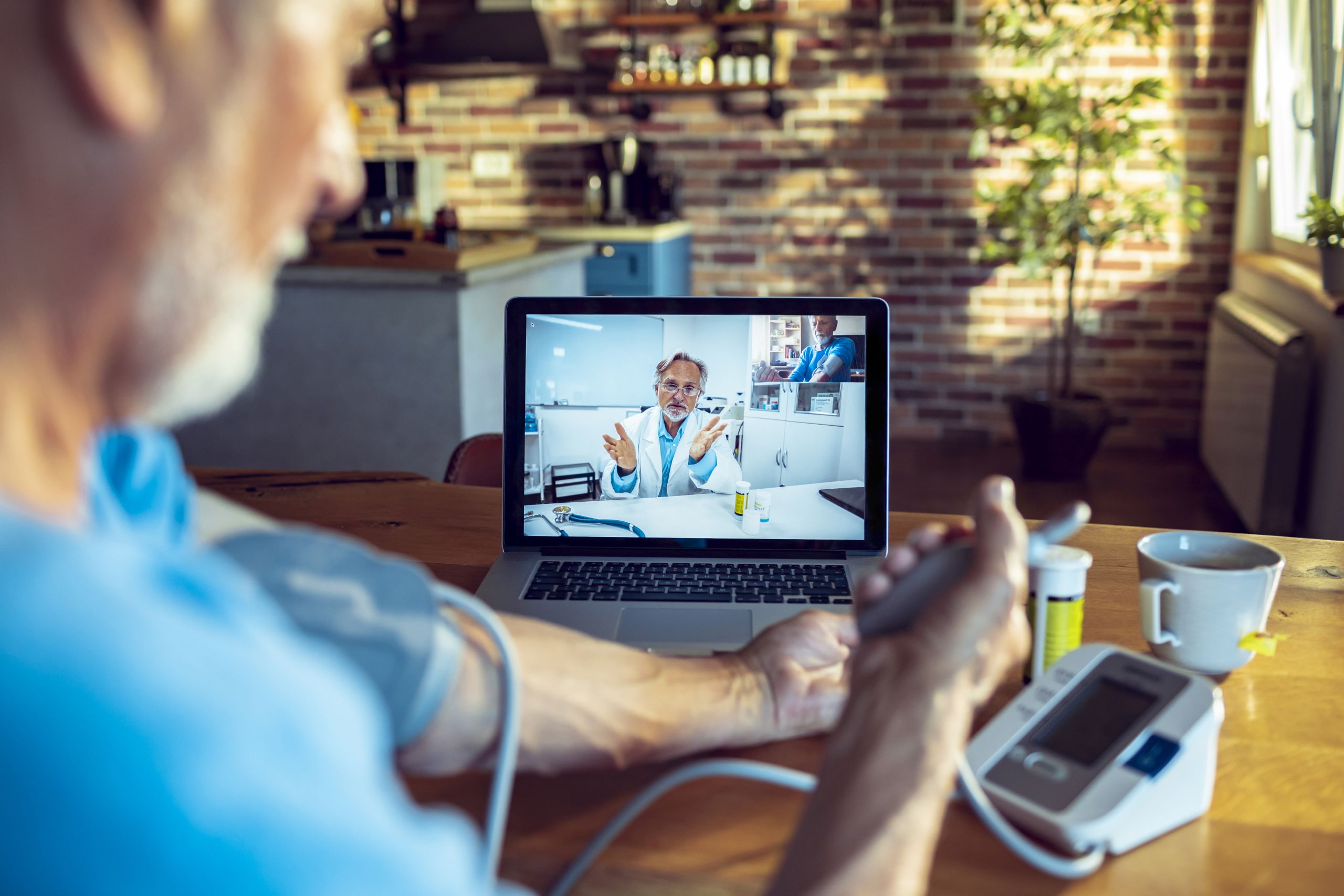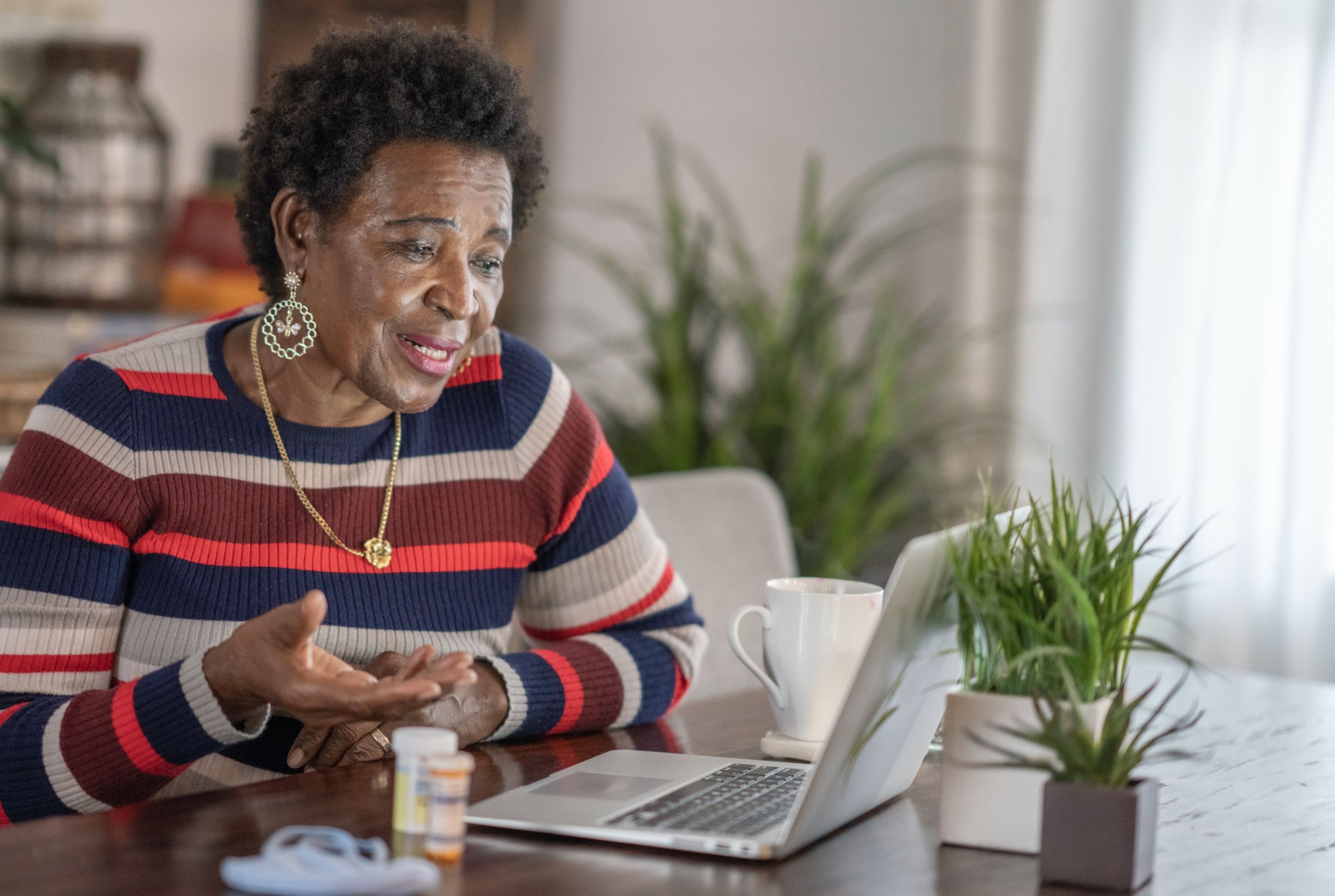On Digital Inequalities
Analysis and ideas on addressing digital inequalities

Foreword
Helen Milner OBE
COVID-19 changed nothing and it changed everything. Over a year on and millions of people are as excluded now as they were before the first lockdown period, lacking the skills and affordable access they need to be part of our increasingly digital society.
But COVID-19 also changed everything because suddenly everyone else was aware that they could not live without the internet. For those people able to use technology comfortably and confidently, shifting everyday life online has been strange and unexpected, but not exactly a leap in the dark. For those millions who can’t, a year of lockdowns has meant being literally cut off from the world and essential services – leading to loneliness and social isolation.
We are seeing increasing evidence – referenced throughout this important publication – that the pandemic has entrenched and magnified inequality in all areas of life, from health to income, employment to housing. We’ve not experienced the pandemic equally, and we will definitely not all be experiencing the next months and years of recovery equally.
During the early days of the pandemic we set up an emergency response project with FutureDotNow, supported by donations from businesses. Through Everyone Connected, we've successfully distributed 13,000 devices and data packages – along with digital skills support – to the most vulnerable adults and families in communities.
While we’re proud of what we achieved in a short space of time, the country with the fifth largest economy in the world shouldn’t need to fall back on emergency responses to ensure people can have GP appointments, get financial support and maintain a lifeline to loved ones.
As is highlighted in this publication, there are 9 million adults in the UK who can’t use the internet without help. That’s not okay. Nor is it okay that, in England, the digital divide is a North/South divide: 53% of people in the North East and 41% in the North West are either non-internet users or very limited users, compared to 35% in the South East.
It’s time for the UK to have a truly inclusive digital strategy. We need an ambition that we can close the digital divide – because we can. An ambition for a levelled-up 100% digital-included nation, and sustainable solutions to data poverty.
No longer should people have to make the choice between data and food – we know from our community partners that some people have had to make this choice in the last year. We need a globally admired ambition and joined-up plan – a national roadmap setting out the milestones along the way.
Industry, civil society and communities are ready right now to work together, with governments, to make this happen. At Good Things, we and our national network of independent community partners in the Online Centres Network are poised to play our significant role.
Just as we’ve heard the Prime Minister’s roadmap for coming out of lockdown, we now need a roadmap for fixing the digital divide as a social and economic priority.
Helen Milner OBE is Group Chief Executive of Good Things Foundation.



The digital economy could be more productive – but will it be more inclusive?
Professor Bart van Ark

Digital technology has helped us cope with the COVID-19 pandemic. But it is essential that the productivity gains from digital technology adoption become less divisive, and more inclusive. Better access to the sources of productivity, inclusive productivity measures, and coordinated and evidence-based policymaking are key to making digital technology benefit all.
An introduction from Professor Bart van Ark
An unequal aftermath of the pandemic
Along with the vaccination rollout and the search for a safe exit from restrictions in mobility, in early 2021, global attention is beginning to turn to the economic and social aftermath of the pandemic. A key concern is that COVID-19 is exacerbating pre-crisis inequalities. The virus has not only been much more dangerous for the elderly and those with underlying health conditions; it has also put those living in socially and economically deprived areas, ethnic minority groups, and those in service sector occupations that require in-person interactions, at the greatest risk – health-wise, economically, and socially. While the initial effects on income distribution will largely depend on the unwinding of the temporary income and business support measures, there are likely to be lasting effects on especially younger people experiencing the scarring effects of lost education and an erosion in skills because of weaker job prospects and slower upward economic and social mobility.

The power of digital transformation
One silver lining of the crisis has been the increased adoption of technologies, especially digital goods and services. More than one third of the UK workforce worked from home from mid-October to mid-November 2020, obviously with the help of digital technology. Some schools adapted quickly to online learning, and digital technology helped sustain some non-COVID-19 health services through video consultations. Online spending helped some companies to ramp up their digital provision of goods and services, and many doubled down on digital transformation in an attempt to strengthen supply chain resilience. These factors have almost certainly supported productivity in the short term, which after a fall in the first half of 2020, has seen a decent recovery since.
Widening digital inequalities
The acceleration in digital transformation has also laid bare some of the societal divisions in terms of access to, and benefits from, the digital economy. For example, schooling or working from home becomes hard when bandwidth is low or there are not enough digital devices in the home. Inadequate working spaces or difficulties in providing parents with support for home schooling are often linked to existing social and economic inequalities. Online consumption works for those with credit or debit cards, but not for those who largely live on cash or have no means to safely access and store their information. And while simple digital technologies, such as videoconferencing have been widely adopted by most SMEs, it is harder for them than for large firms to implement online marketing and sales or complex digital strategies.
The impact of digital access and the skills divide was already visible before the pandemic, widening the gap between the most and least productive firms, and feeding through into increasing wage inequality.
The risk is that as we find our way out of the crisis, the short-term productivity gains from adopting digital technologies will not reverse the pre-crisis trend. Even worse, the recent acceleration in digital transformation may exacerbate the societal divisions in terms of access to, and benefits from, the digital economy.
The distribution of the productivity benefits may fuel a K-shaped recovery, making sectors, firms, and people with the most resources at hand do even better, whereas others stay behind. New digital technologies may only exacerbate these effects by putting occupations with tasks that can be easily automated most at risk. While those jobs were originally typically in the middle-income range, the emergence of robotics and AI is starting to squeeze out manual tasks concentrated in lower-income jobs such as retail and warehousing – in fact, exactly the kind of jobs put at risk by the lockdowns.

Rethinking productivity
It is essential that the productivity gains from digital technology adoption become less divisive, and more inclusive. Productivity may be more often thought of as related to efficiency gains rather than tackling inequalities. But there is another side to the productivity story. Productivity raises the returns on digital investments and can free up the resources for firms to expand and sustain new innovations. To trigger this virtuous investment-productivity cycle, we need a more inclusive approach to productivity.
To strengthen the link between digital technology and inclusive productivity requires progress on three fronts:
- Broader access to the sources of productivity growth. Better access to broadband and digital devices provides the technical means for productivity to advance. But to make use of technologies, people need to be able to improve their digital skills, inside and outside the workplace. Inside the firm, better management competencies and innovation practices can leverage the skills of employees. An emphasis on diversity and inclusion to drive innovation will also empower individuals in the organisation to make full use of digital capabilities. Collaboration between businesses, government, schools and colleges at local and regional level will help further create a high-trust and dynamic environment, and spread the benefits from adopting and using digital technology to other firms and the community as a whole.
- New measures of inclusive productivity. We need to consider the impact of digital technology on GDP, productivity and wellbeing, rethinking current measures of output and inputs. More informative measures of output should capture quality improvements in digital products and services, including better functionality, improved access, and the benefits of free content. Inclusive input measures will not only count how many hours people work, but also how better skills contribute, and what people provide in terms of personal data in exchange for free content.
- Coordinated and evidence-based policies. For productivity to drive inclusive growth we need an integrated set of institutions and policies across many players. Co-ordination is needed across policy domains, including education, digital, fiscal, innovation, housing, infrastructure and structural policy areas as well as between national, regional and local entities. Inclusive productivity requires a long-term focus and should not be hindered by policy-churn. Policies, therefore, need to be properly monitored, evaluated and compared on their effects.
Coming out of the pandemic, the choice is between a recovery for all or leaving more people further behind. A concerted effort by business executives, policymakers, education leaders and workers in making productivity more inclusive, can make the difference.
Bart van Ark is Professor of Productivity Studies at the Alliance Manchester Business School, The University of Manchester, and Managing Director of The Productivity Institute.


How the digital healthcare revolution leaves the most vulnerable behind
Dr Omer Ali, Dr Elizabeth Dalgarno, Dr Claudia Pagliari, and Professor Arpana Verma

The COVID-19 pandemic has driven many of our activities online – including healthcare. While the digital revolution in the NHS has brought many benefits, further shifts such as remote consultations and monitoring during the pandemic, have the potential to leave people behind. Now, more than ever, digital skills are needed to navigate the world, especially while social distancing and restrictions mean that we spend more of our time online, but for many people this is not possible. The UK government aims to transform patient outcomes through technology, but does this benefit everyone equally? And who is left behind?
Digital access is not enough
Ensuring the whole population has access to the internet is vital in the technological age, yet access to digital services in the UK is deeply uneven. Currently, 4% of UK households do not have internet access, 3.8 million people (7% of the population) have never used the internet and 9 million cannot use the internet unassisted. The older and more deprived you are, the less likely you are to be digitally engaged, with lower socioeconomic groups more likely to face barriers to getting online and less likely to have the skills to use digital devices. People with disabilities are also less likely to be online. We know that these groups are disproportionately affected by ill health and are at more risk of complications related to COVID-19 and to suffer from social isolation – these differences have only been highlighted further by the pandemic. In light of this, the NHS should measure the use of digital health services by these groups and how this impacts on access to healthcare; after all, they are the biggest users of healthcare services. Digitisation of patient-facing services in the NHS needs to explicitly include strategies to engage these groups and ensure health inequalities are not widened even further.
The importance of access to the internet is reflected globally in the United Nations (UN) Sustainable Development Goals (SDG 17.8). However, access is of no use if people don’t have the skills to make best use of the internet.
Access to the internet across British households - data visualisation from Policy@Manchester.
Improving digital skills in the clinically vulnerable
Digital literacy can be enhanced by targeting the most vulnerable with mass digital literacy programmes. This could be done through expanding projects such as the NHS Widening Digital Participation Programme which delivered digital skills training through local hubs working together with councils, libraries, community groups and volunteers thanks to a collaboration between the NHS and the Good Things Foundation. Scaling up this network further could help reach the estimated 23.5 million who have low to very low digital engagement according to the Consumer Digital Index.
Targeted skills training could begin by identifying clinically extremely vulnerable and shielding groups. They are at high risk of complications related to COVID-19 and isolation related to social and digital exclusion. This could also be led on a locality level such as the Greater Manchester Digital Inclusion Taskforce. This will allow for targeted skills training for those most in need. We should bear in mind that many older adults do use the internet successfully and as many as 26% of those aged 70-79 consider themselves digitally skilled.
Ethical questions in digital healthcare
As we increasingly move more of our health services online, we should also consider the ethical implications: could we be widening health inequalities by moving more of our health service online? Is the increasing trend towards remote monitoring necessary? Who owns the data that is collected and how is privacy safeguarded? Will it result in a better experience of care and better treatment or will it compromise patient safety?
We must recognise the privacy concerns of patients. According to the Information Commissioner's Office, healthcare accounts for the most personal data breaches, making up 19.7% of the total. Concerns around privacy became particularly prominent in the wake of the failed Care.data launch in 2013, along with more recent concerns surrounding the Test and Trace app. There is a growing concern around whether digital interventions can maintain the same level of ethical principles afforded to patients prior to these digital innovations. Respecting autonomy or ‘self-rules’ may not be achievable if individuals are implicitly coerced into accepting these changes against their will. Healthcare should be justly available to all and ensure access to care with digitisation is equal. Furthermore, it is those with the least digital literacy that we often exchange the most information about, such as those on the shielding list or in social care. This raises questions of power and control and whether digitisation and data sharing always really empowers the individual.
Digital literacy should not be viewed on its own – it intersects with many other aspects of health, and health literacy often overlaps with digital literacy.
People with low literacy are more likely to experience increased hospitalisation or death and less likely to engage with preventative health, which is why health literacy campaigns need to run alongside digital literacy campaigns. Additionally, often the facilities available to people locally dictate what support and services they can access; ensuring there are facilities with free digital devices and support on how to use them, should be prioritised so that nobody misses out, including during lockdowns.
Digital, health and financial literacy
The pandemic has highlighted the gap in achieving equal access to education for children who do not have digital devices and we know that education and health are intrinsically linked. We also know that globally there is a gender digital divide, with girls and women having less access to technology and the internet. Without a combination of digital, health and financial literacy it will be very difficult to break out of a cycle of poverty and ill health. To study the best ways to tackle this and co-produce a solution with local communities, we are working with communities in Doncaster, West Cheshire and Manchester alongside academics from across the country to identify research questions that matter most to them and co-produce solutions to the above. We hope that by taking a collaborative approach we will be able to achieve lasting solutions that work for the most deprived communities in our towns and cities.
Digitising health services should be more than just putting services online. Many communities will require access to free-to-use digital devices, internet, and active support, and it is likely that a large campaign will be needed to improve digital literacy for all. Particular attention should be paid to ensuring that an ethical approach is taken and patients and the public are involved in leading the design of digital health projects, to ensure their specific needs are met.
Omer Ali is Lecturer in Public Health and a member of the Epidemiology and Public Health Group at The University of Manchester.
Elizabeth Dalgarno is Lecturer in Healthcare Sciences and an NIHR Fellow at the Integrated Interdisciplinary Innovations in Healthcare Science Hub at The University of Manchester.
Claudia Pagliari is Senior Lecturer in Primary Care and Informatics and Programme Director for the MSc in Global eHealth at The University of Edinburgh and co-founder and a theme lead of the NHS Digital Academy and Chair of the National Expert Group on Digital Ethics in Scotland.
Arpana Verma is Clinical Professor of Public Health and Epidemiology, Programme Director of the Master in Public Health and Head of the Division of Population Health, Health Services Research and Primary Care at The University of Manchester and Honorary Consultant at Public Health England.


Employability meets education: why essays and exams are not enough
Drew Whitworth

The traditional role of assessment has been to demonstrate mastery of disciplinary knowledge. The common methods are the examination, which tests recall and on-paper problem solving, and the essay, testing how well the learner can synthesise and articulate knowledge. But while these methods may effectively test the ‘know-what’ of an intellectual domain and require the application of some generic skills (such as numeracy), they are less effective when testing a learner’s ability to apply that knowledge in a domain of practice — that is, the ‘know-how’. There’s still a perceived hierarchy of assessments, rooted in gendered and classist thinking. Yet arguably, less traditional, project-based assessments, whether conducted off or online, allow the learner to demonstrate skills more relevant to their future employment. So, is it time to move beyond the standard model of online essays and exams?
An introduction from Drew Whitworth.
Traditional versus practical forms of assessment
Research into workplace and community learning has identified its social and practical character. Whether one is applying one’s learned knowledge within a business, a social enterprise or a sports club, to work effectively, one must be able to gather information, make judgments about its relevance and communicate these understandings to others. In most practice settings, one will never need to write an essay, but must present information in different ways, whether to a client, colleague, or member of the local community. Increasingly, this will take place through some kind of digital medium.
Such work requires good communication skills and the ability to work as part of a team, and these are often declared by employers to be important graduate outcomes, yet the standard approach to assessment overlooks them. Policy that lauds the essay or exam at the expense of more practical forms of assessment — such as presentations, project work, group activities, performances and the use of alternative publishing media like blogs — is thus doing learners a disservice. Exams and essays do not offer opportunities for students to develop, demonstrate and — importantly — have validated the communicative and teamwork skills necessary to be an effective practitioner.
Assessment is not just an outcome of pedagogy and course design, but a response to policy.
What we assess, and what learning outcomes we thereby accredit, is a significant means by which learning is influenced and directed, on a societal scale. The current disconnection between traditional modes of assessment, and the need for at least some integration of a more practice-based approach, is evidence of more than just inertia.
Assessment is a discourse, a way by which those with authority can specify that these are not only the knowledge domains, but the human characteristics, that are valued by the state and the economy. In this long-standing discourse, ‘vocational’ skills and programmes are defined as ‘lower-class’, and also often feminised. In the 1960s, working class girls and women were encouraged onto secretarial programmes and then into the typing pool. More recent (2012) research in the US demonstrates that this is still the case, showing that lower-income, ethnic minority women were plugged into digital networks, but in an exploitative way – exhibiting ‘digital skills’ but unable to turn them to their own empowerment. It remains to be seen whether the widespread shift to online work patterns that has taken place as a response to COVID-19 will reduce or exacerbate this divide.

Employability tracked through technology
On the other hand, even the more elitist institutions are now obliged to formally measure the employability of their graduates and demonstrate how a university education adds value to the individual.
Advances in technology pose a challenge to the view that demonstrated practical ability is regarded as lower status, compared to ‘purer’ intellectual skills.
Graduate recruiters now have access to analytic tools that can search the internet for evidence of what a particular candidate is like to work with, through reviewing that person’s online presence. They can look beyond just the list of qualifications, the degree certificate and transcript, and references. If a candidate has identifiable examples of work available online in various media, creative projects such as films, games or a blog, these can be incorporated into a broader assessment of what that person can do and how they fit a job description, not necessarily at the expense of a degree transcript, but certainly supplementing it. And if this work has also been validated by a formal assessment, offered by an accredited educational institution of some kind, that makes it all the more valuable.
Integrating a more practical approach into assessment has been identified as beneficial for two other aspects of education policy. The first is the widening participation agenda. Recognising that there is no reason why a work in digital media should necessarily be less scholarly than an essay, and that it would also be more likely to be seen by others (including potential employers), admits those students for whom ‘writing’ in the traditional sense is difficult, perhaps because of learning difficulties, or simply because their talents lie more in these other realms, to the world of academic discourse.
Upholding the integrity of assessments
Secondly, assessing a student’s practice, their work in context, also counters the increasing use of online essay mills and banks, and the threat these pose to the integrity of assessment across the sector. Mills and banks appeal in a system geared up to assess answers, or words — that is, submitted exam or essay papers. But if assessment is of the student’s practical performance of their knowledge, in a specific context — applying the disciplinary knowledge they have learned to performing a task, making an utterance, interacting with an audience — it is very difficult to acquire such material ‘off the shelf’, or to have someone impersonate the learner by writing a submission for them.
COVID-19 shattered the UK school examination system in 2020, and it seems set to do the same in 2021. Yet the more vocational, coursework-based BTEC assessments are scheduled to happen as normal. Recent research has illustrated how the UK policy on assessment was thrown into a state of disorder by the virus, with at least two ‘windows of opportunity’ for change having already been missed. The January 2021 FE White Paper mentions ‘digital learning’ and ‘digital skills’ only in passing, without an attempt to define the latter.
While I am not arguing against the continued use of exams and essays, education policymakers need to recognise that a practice-based approach to assessment reduces inequality of educational outcomes and enhances employability. The case for incorporating a much higher proportion of alternative assessments methods is clear and if one outcome of the present crisis is a substantial shift to online modes of learning and assessment, practice-based approaches of online assessment are more fit for purpose in the short and longer term.
Drew Whitworth is Reader in the Manchester Institute of Education, The University of Manchester.

Accelerated automation, digital advances, and employment in the world of food retail
Abbie Winton

Supermarket shopping of old has, perhaps, changed forever. For most food retailers, trading online has long lacked appeal due to the low margins which it offers, making it less profitable than operating from brick-and-mortar stores. However, the coronavirus pandemic triggered an unforeseen shift as many consumers moved to buying food online (growing 25.5% in 2020 compared to the 8.5% previously anticipated). This prompted retailers to expand their dotcom offering almost overnight to both meet demand and stay competitive during a time when customers were restricted in their ability to do their shopping in-store. Alongside expanding their in-house logistics services, five of the big-name supermarkets started to use external delivery services provided by Amazon, Deliveroo and Uber Eats.
An introduction from Abbie Winton.
A surge in supermarket employment
To meet the excess demand, all of the major retailers took on additional workers. Some were hired permanently in areas which were expanding for the first time, while others were hired temporarily as retailers tackled the uncertainties presented by the national lockdown. Online recruitment mobilised vast numbers of potential workers, many of whom had been furloughed or made redundant from their previous jobs. Highly precarious contracts were offered in large numbers, meaning employees could be more easily let go when demand eased. Some were hired temporarily to minimise the effects of panic buying on stock, yet the majority of new jobs were in warehousing and logistics (including picking, packing and driving) to service the move to online shopping.
The gendering of retail work
Retail work has historically been gendered in terms of the roles which men and women carry out. For example, the move online and growing use of self-checkouts in-store have in part helped facilitate a reduction in the need for checkout staff. These jobs have long been disproportionately filled by women who needed the ‘flexibility’ to manage work alongside caring responsibilities. In contrast, there has already been an expansion of new roles in warehousing, logistics and fulfilment which have traditionally been filled by men and demand hours less likely to suit the needs of the household.
Although there have been some improvements in the occupational segmentation of retail roles in recent years, changing demands mean the future of work in food retail is likely to be somewhat gendered if current patterns persist. To avoid exacerbating these gender inequalities, measures are needed to ensure women are equipped to enter into logistics and distribution; for example, employee-led flexible working arrangements and parental leave would allow for an easier transition into these roles.
High versus low tech models
While online shopping was stimulated during the crisis, the method for fulfilling these orders remained heavily reliant on labour instead of technology. Although some retailers have begun to expand into semi-automated warehouses to fulfil orders, most of the picking and packing is carried out on the shop floor or in centralised distribution centres by members of staff. Predicting a sustained move online, food retailers have made their plans to open new regional dotcom distribution centres across the country public. If these jobs are to be accessible to all, additional considerations will have to be made.
Research has shown that women are more likely to rely on public transport to get to work and thus tend to take jobs which are closer to home/schools. However, distribution centres tend to be located in harder-to-reach areas, making these jobs less accessible to women. Therefore, provisions would have to be made to improve transportation routes to these areas (both in terms of accessibility and safety). Secondly, the ‘pick rates’ which dictate dotcom work can often be challenging for disabled and older workers to sustain. Reasonable adjustments will be required where necessary to accommodate for these groups. Finally, moving from a customer service to a logistics-oriented role might not be preferable for all workers. Accounting for this, further measures may have to be put in place for workers choosing to leave the sector, such as extending the reskilling bootcamps already provided.
Within the sector, Ocado is the only major exception to the human labour approach. As a leader in warehouse technology, Ocado already has a portfolio of hi-tech fulfilment centres which use propriety-design ‘bots’ to pick and pack orders. This is likely to be a desirable model to pursue in the longer term for those retailers with the capital to do so. However, for those who do not, they may approach the Ocado-model with some caution. Ocado had to temporarily suspend new orders as they were unable to expand capacity in the same way as other retailers, yet others were able to expand capacity by taking on a large hyper-flexible pool of workers to pick up the work which technology could not. If this approach to organising labour is deemed more convenient to retailers post-crisis, it could detrimentally impact the quality of work available in the sector in the future.
Characteristics of new retail work
Attempts to outsource labour are becoming more common throughout the sector. In a recent case, it was brought to light that outsourced drivers at Sainsbury’s were being paid up to £12,000 less than direct hires. However, prompted by the demands of the crisis, many more have opted to outsource delivery to third-party platforms to avoid the costs associated with developing their in-house infrastructures. Partnership agreements with platforms such as Deliveroo, Uber Eats and Amazon have allowed food retailers to make use of the low-cost delivery services offered by these providers, which rely on a network of bogus self-employed couriers to fulfil same-day deliveries.
The longevity of this approach beyond the crisis remains unknown, yet it is a concerning development for the future of employment relations in that growing segment of the sector. The quality of work available within the sector could deteriorate as mentioned, but the quantity of work available could also decline if some choose to adopt an approach, similar to Ocado, which relies on longer-term investments in ‘big-ticket’ automating technologies. However, there is little evidence as yet that either approach is likely to dominate regardless of what certain predictions suggest.Therefore, policymakers should ensure that the jobs which remain do not reinforce the existing inequalities which are endemic to service work and have been further exacerbated by the current crisis.
Abbie Winton is a final year PhD Researcher at the Work and Equalities Institute at The University of Manchester.


Why we must act now to confront the new global digital divide
Dr Chris Foster and Dr Shamel Azmeh

Over recent decades, concern has been mounting over the issue of the digital divide – the unequal access to the latest technology and the networks that support it. This issue has attracted growing attention from policymakers and NGOs at national and international levels. Efforts have typically focused on maximising the benefits that come from the digital economy by expanding inclusion, especially in developing countries. This has led to programmes supporting local content creation and the building of internet skills and infrastructure. Many studies highlight the positive impacts of such initiatives, in areas such as financial inclusion, access to information and better government services. Clearly this is an important foundation, but is it enough?
A wider view for a changing economy
Building on what we already know, we need to develop a more holistic understanding of how users, firms and nations are excluded from, or else unfavourably integrated, into the digital economy. Firstly, the digital economy is highly global in nature, as shown for example in the exchange of goods and services across national borders, where transactions or coordination occur online. Secondly, cross-border digital platforms are threatening to dominate important areas of the economy and are driving transformation in several sectors. Well-known cases such as social media or transportation apps like Uber receive a lot of media attention, but similar dynamics can be seen across a growing range of economic sectors. Underpinning these two trends is an expanding digital infrastructure to collect, transport, store, and use data that is dominated by a small number of leading digital firms such as Google and Amazon.
Control, risk, and a new digital divide
These shifts in the digital economy pose important questions for nation states around sovereignty and control. The dominant role of large digital firms is one aspect, enabling them to exercise high levels of control in the digital economy through providing key infrastructure and services. More broadly, these shifts are enabling multinational firms to generate revenues and value across a growing range of economic sectors and to shape the organisation of those sectors globally.
The effects are felt across the world, but our research has focused on developing countries where we see substantial risks, and where there is a lack of resources and social safety nets to deal with the societal impacts of digital transformation. Major economic powers, such as the EU (who also see themselves behind the curve in these areas) have looked to leverage their economic and political power to extract benefits from digital transformation and challenge the global monopolies of digital lead firms. But for developing countries, particularly smaller ones, a lack of resources to adopt effective industrial strategies and to invest in the capabilities needed to benefit from these shifts limits a similar approach. Often, the smaller size of their markets limits their ability to leverage market access to extract investments from the global digital firms.
This is the foundation of the global economy’s new digital divide. Developing countries have rightly welcomed the expansion of the digital economy and the growing diversity of consumer services and infrastructure. But these trends come against significant structural risks of digital transformation driving dominance of international firms, the challenges in uneven extraction of profits from developing economies, and a widening gap between technological leading economies and adopters.
The accelerating pandemic effect
The COVID-19 pandemic has accelerated the urgency of these issues. Governments rapidly imposed a range of restrictions to limit the spread of the virus with travel becoming more difficult. The use of digital technology as a medium to trade and as a way to deliver products and services has been an important component of resilience during the crisis. In many industries, a common refrain is that the first six months of the pandemic accelerated digital transformation by two years, even five years in some sectors, where firms rapidly implemented digital plans. Meanwhile, the agendas of multinational tech firms, digital platforms and those involved with data are increasingly being subject to scrutiny in terms of regulation around their market power, their use of personal data and as part of broader geopolitical conflicts.
New policies for new challenges
Thinking about the digital divide from a broader, global perspective should prompt a rethink of how developing countries treat digital exclusion and inequality. The ‘old’ issues around digital inclusion are only one part of a broader discussion on how nations confront new structural challenges concerning digital technology. Our research has highlighted the important role of policy to address these challenges. Developing countries cannot just sit by as these trends unfold but need new policies to guide, control, shape and regulate digital economies within core economic agendas around national capability-building, inequality and employment. In countries such as Indonesia and Brazil we are beginning to see policy interventions in areas including taxation, platforms, and digital jobs, with indications that such policy can become more strategic in the future. As global discussions have emerged around reforming rules in areas such as data and ‘digital trade’, developing nations such as South Africa, India, and a number of African countries have been instrumental in ensuring the challenges of developing countries remain on the agenda in negotiations, typically skewed towards narrow goals of a few leading economies.
The expansion of digital technology has been celebrated as a way to reduce global inequality. Today, however, we can also see the multiple ways through which digital technologies are driving a higher concentration of wealth and control in the global economy. Further research is needed to explore these complex impacts of the digital revolution and to examine how international, national, and local policies can be mobilised to bridge the digital divide not only in terms of access but also in terms of capabilities. Without greater awareness and action to tackle these issues, the global economies digital divide is liable to expand, with the potential for further loss of sovereignty and with implications for inclusive growth and global inequality. Ultimately, how these issues are addressed in the coming years will be vital for the future of the internet as a global and open resource.
Chris Foster is a Presidential Fellow at the Global Development Institute, The University of Manchester.
Shamel Azmeh is a Lecturer in International Development at the Global Development Institute, The University of Manchester.


Falls prevention in a digital age: addressing the digital divide
Dr Lisa McGarrigle and Professor Chris Todd

As we age, the risk and actuality of falling becomes a much greater concern. This is not just an issue for the individual but also for wider society, as the consequences of falls can often result in costly long-term care. The coronavirus pandemic has brought digital approaches in healthcare to the fore and there are promising new tech-driven initiatives to support falls prevention; however, inclusive policymaking is needed to ensure older people, particularly those left behind in the ‘digital divide’, can make full use of them in order to prevent falls.
An introduction from Dr Lisa McGarrigle.
Falls as a public health issue
Falls represent a serious public health problem, particularly in the context of an ageing population. Consequences of falls include injury, death, hospitalisation, admission to long-term care, with substantial cost implications for health and social care. Effective falls prevention programmes should employ evidence-based prevention strategies to modify risk, such as environmental modifications, medication, and assistive devices. Exercise interventions, particularly those targeting strength and balance, are considered among the most effective when it comes to preventing falls in the community.
Preventing falls in a digital age
In the UK, the Chief Medical Officers’ guidelines state that muscle-strengthening and balance exercises should be performed at least twice weekly by those aged over 65. These exercises must provide an appropriate level of challenge and progress in difficulty at a rate appropriate to individual ability levels. Evidence-based programmes, such as the Otago Exercise Programme, the Falls Management Exercise (FaME) programme, or the Lifestyle-integrated Functional Exercise (LiFE) programme, are designed to do just that and are usually delivered in face-to-face classes run by trained professionals.
Recently, there has been a move towards digital approaches to facilitate exercise and promote physical activity. For instance, our group has developed smartphone and tablet-based technologies for older people to help them maintain optimum levels of exercise, nutrition, hydration and bone health (eg the Keep On Keep Up app, motivational apps, and rehabilitation exercise teleconferencing). These interventions may offer cost-effective and accessible means of engaging older people in exercise, particularly those who are unable to attend face-to-face classes for reasons such as disability or lack of transportation.
Although research on the effectiveness of digital approaches in falls prevention is in its infancy, there have been promising indications of its potential. Even so, appropriate consideration must be given to the risk of exacerbating inequalities through increased digitalisation of services, as we know that older and more disadvantaged sectors of society are less likely to have access to or experience with such technologies. For people who lack digital literacy skills or internet-enabled devices the benefits of these approaches are unclear, and we run the risk of alienating groups that might otherwise have engaged with traditional services. To mitigate this risk, we must be aware of who is being negatively affected and develop targeted policies to promote inclusion.
Who is being left behind?
It is likely that digital technologies for exercise will have greater appeal with generally healthy, and quite probably younger, older people who already have experience with and feel comfortable using such technologies. Access to the internet and internet-enabled devices is another major factor affecting participation, with the majority of those identifying as non-internet users aged over 65. Other contributing factors to this digital divide include socio-economic status, literacy, health issues such as visual impairment or cognitive decline, geographic location, and cultural factors. Furthermore, technologies are often designed without older people in mind which can result in devices that appear overly complicated and off-putting to some.
Ensuring equal access to such technologies, coupled with the provision of simple to use apps and devices and technical supports for those who need them, would help to level the playing field when it comes to technology use amongst older people.
Bridging the gap
The COVID-19 pandemic has propelled us into a digital world. In the rush to move information and services online, digital poverty has been put in sharp focus. There is a growing need for an action plan and funding to address this. From a policy point of view, much can be done to help bridge the digital divide. This is already a key priority in the 2019 Public Health England prevention Green Paper where the aim is to provide freely available digital products and services to older people, as well as those living with health conditions or people on low income. In order to achieve this aim, investment from government and service providers is crucial.
As cost is a factor for many non-internet users, subsidised internet access and internet-enabled devices could go a long way towards encouraging older people to get online. As an example of how this might work, we can look to the Department of Education’s (DfE) ‘Get Help With Technology’ programme. In response to the closure of schools due to the COVID-19 pandemic, the DfE has partnered with mobile network operators to provide disadvantaged children with increased mobile data. A similar scheme could be applied to older people lacking a broadband connection, particularly those who can no longer attend face-to-face exercise classes due to physical distancing measures. Government departments (such as the Department of Health and Social Care; the Department for Digital, Culture, Media and Sport; and the Ministry of Housing, Communities and Local Government), local authorities, and internet service providers could work together to prioritise connecting older age groups with high-speed broadband at reduced rates.
Once the issue of equal access is addressed there will still be many barriers preventing older people from engaging with online supports and services. A recent policy briefing paper by the Centre for Ageing Better emphasises the lack of digital skills as a key factor, as well as lack of confidence amongst older people in their ability to navigate digital supports. It is essential that free public services providing personalised supports are available in tandem with increased access for those who wish to develop skills and confidence around technology use. In addition to policy approaches, the development of falls prevention technology that is acceptable and engaging to older people through user-led design is an important step towards increasing uptake and adherence to technological interventions. As digital health continues to evolve and extend its global reach, implementing these recommendations will ensure that the associated benefits are accessible to all.
Lisa McGarrigle is NIHR Research Fellow with the Healthy Ageing Research Group at The University of Manchester.
Chris Todd is Professor of Primary Care & Community Health, School of Health Sciences where he leads the Healthy Ageing Research Group. He is also Director, NIHR Older People and Frailty Policy Research Unit and Lead, Healthy Ageing Theme, NIHR Applied Research Collaboration Greater Manchester.


Homeworking experiences during lockdown
Professor Debra Howcroft and Professor Phil Taylor

In March 2020, evacuating the workplace became a key policy instrument to curtail the spread of COVID-19. This saw an unprecedented move towards homeworking as the UK government recommended that anyone who could work from home, should do so. While the en masse relocation of white-collar work was initially viewed as an emergency response to restore operational capacity, this is now looking like a potential watershed moment. Experiences differ based on sector, employer and role, and this article looks specifically at call centre workers.
Teleworking of old
The assumption that digitalisation will transform work organisation has long been debated. When teleworking was introduced in the mid-1970s, it led to romanticised visions of a technology-inspired future, with Alvin Troffer’s prediction that the ‘electronic cottage’ would shift 50-80% of jobs back to the home. This perspective assumes that if technical capability exists, adoption is inevitable, regardless of wider political, economic, organisational, locational and spatial contexts. However, take up has been slow and this is largely attributed to a lack of trust-based working arrangements with teleworking seen as a perk for the already privileged cadre of managers and professionals. In 2019, just over 5% of the total UK workforce mainly worked from home.

Lockdown for call centre agents
Prior to the pandemic, call centre workers were predominantly office-based, which is reflective of their labour market position as predominantly lower-skilled, white-collar workers with limited autonomy. A 2020 survey conducted by one of the authors asked call centre workers about their experiences of relocating from the office to the home, which took place during the first two months of lockdown (March-April 2020). The findings show that when speed of transfer to the home was critical, connectivity problems (23.2%) and the lack of IT equipment (20.1%) caused delays, leaving workers consigned to offices which were deemed no longer safe.
Further hold-ups related to management action or inaction were reported, with one respondent explaining that senior management had expressed concerns that productivity would fall. Such delays had health-related consequences, with two-thirds of the workforce in one office having to contend with self-isolation. Almost 16% reported that managers had neglected to protect employees from risk in the office.
In contrast with previous ranks of homeworkers, these largely lower-grade workers face various forms of direct and indirect control from managers, some of which are embedded in digital systems.
Control is partly dependent on a range of performance metrics, with more than half (52.1%) reporting that the same targets that operated in the call centre also applied at home. If homeworking implies an absence of visible surveillance, the evidence suggests concerted managerial efforts to overcome it through micro-management. This represents a particularly harsh form of management, given the demands of domestic responsibilities, home-schooling, and make-shift working arrangements. A significant number of workers (28%) stated that targets were either too rigid or unachievable and that they should be revised or even removed.
Control extended to monitoring by team leaders, which is perceived as the outcome of a pervasive lack of trust on behalf of managers – 41.3% of homeworking respondents commented that monitoring occurred to the same degree as in the workplace. Embedded forms of digital control operate, generating real-time performance data, prompting intervention by team leaders via the use of email, message alerts or telephone contact. Issues regarding visibility are featured in numerous testimonies, particularly concerning the use of recorded video-based digital platforms such as Zoom, Microsoft Teams and Skype. A recurring theme was that of feeling infantilised as some are required to email their manager when returning from using the bathroom.
Workers expressed strongly held views that there should be flexibility in relation to shifts, breaks and schedules, even though two-thirds (67.8%) were subject to the same temporal patterns of work. Overall, employers were unwilling to make adjustments during such stressful times.

Flexibility to support home life and mental wellbeing
Concerns around the deterioration in mental wellbeing during lockdowns are well documented. In the case of call centre agents, one in two reported missing social interaction with colleagues. This went beyond workplace humour and banter, extending to the erosion of peer collectivism which had functioned as a support mechanism to counter management control or ease workload. Social media helped slightly but was unable to compensate for the loss of immediacy and interdependent work activity.
When asked to comment on the most negative aspects of homeworking, problems of distraction or interruptions and the negative consequence for work-life balance were frequently reported. Workers highlighted the tension between management expectations that they would complete their usual shift ‘no matter what’, with some being asked to make up their hours in the evenings and weekends. These tensions are amplified by the demands faced by single parents.
The teleworking literature rarely addresses health and safety issues, but the recent haste experienced by the transfer of many meant that the third most commonly reported negative aspect of homeworking related to the unsuitability of their ‘workstation’. Problems arose from ergonomic deficiencies, compounded by the neglect of workstation risk assessments. Aside from physical discomfort, homeworking also increases financial costs, with examples of workers having to buy their own equipment and pay for additional utilities.

Improving homeworking equity
For some, including call centre agents, homeworking has brought benefits as well as drawbacks, particularly for those with lengthy commutes. As the reconfiguration of the loci of work continues to unfold, a range of options should be made available to all, extending possibilities beyond the privileged few. These need to broaden the binary of home or office and allow flexible combinations of home and office working to support employees’ domestic circumstances and preferences. This could include a greater understanding of the need for reduced and/or flexible hours, the removal of added stressors associated with performance metrics, and genuine efforts made to support mental wellbeing.
While data protection law places significant limits on employer monitoring of staff, too few employees are aware of their rights and many feel unable to challenge the use of surveillance. Tougher regulation, along with trade union consultation and agreement, is required to prevent employers’ excessive use of electronic monitoring and digital surveillance, both in the office and when working at home.
The risks associated with using display screen equipment must be adequately assessed. For those who are homeworking ‘temporarily’ there is deemed to be no increased risk, which obviates the requirement on the part of employers to carry out home workstation assessments. Regulatory guidelines recommend that employers provide workers with basic advice on completing their own assessment, which contains suggestions such as ‘avoiding eye fatigue by changing focus or blinking from time to time’. This is clearly inadequate. An overhaul of health and safety policy is required to address the needs of increasing numbers of homeworkers.
Debra Howcroft is Professor of Technology and Organisation in the People, Management and Organisation Division of the Alliance Manchester Business School, The University of Manchester.
Phil Taylor is Professor of Work and Employment at the University of Strathclyde.



Only a call away: reducing loneliness and social isolation in older people
Dr Lis Boulton

During the first wave of the COVID-19 pandemic, millions of older adults (70+) across the UK were advised to avoid contact with people living outside their household. This, and the subsequent prolonged periods of national lockdowns and local restrictions, has meant that many people have not been able to spend time in close contact with their friends and family. The shielding requirement put a spotlight on the need to understand how to minimise the impact of loneliness and social isolation. So, what can we do throughout the pandemic and beyond?
Older adults are already more likely to have long-term illness or disability, to live alone and to be widowed, all of which are risk factors for loneliness. Social distancing places them at even higher risk than normal of social isolation and loneliness, which can adversely affect quality of life, wellbeing and mental health, and are associated with physical ill health and mortality. For people living alone, the lack of contact can seem even more acute, particularly if they have been unable to form a ‘household bubble’.
The move from face-to-face support to remote delivery
In the voluntary and community sector, many existing social care services have not been able to operate as commissioned, since March 2020. In some services, there has been a shift to providing remote support instead. Examples can be found in older adults’ day services, where attendance at a centre has been replaced with telephone calls to check in on older adults; group telephone calls to chat with other attendees; and video calls to play games or talk about shared interests. Face-to-face befriending and support services have also had to change their mode of operation to be delivered remotely. This has required rapid service redesign, staff and volunteer training, and new systems to monitor delivery.
What makes an effective remotely delivered intervention?
In order to find the essential ingredients of a successful remotely delivered befriending or social support service, a group of researchers from across the UK conducted a rapid evidence review of reviews in Spring 2020. We identified five different types of remotely delivered intervention, each with a different impact on social isolation, loneliness, or both.
1. Supported video-communication interventions, such as Skype, showed significant decreases in feelings of loneliness and increases in social support scores.
2. Telephone contact was only used in two studies, but qualitative findings showed reduced feelings of loneliness and social isolation.
3. Online discussion groups and forums showed mixed results. The majority of studies showed increases in social support, but only two showed reductions in loneliness.
4. Social networking sites have the potential to reduce loneliness in older adults, but the evidence here is weak. Older adults appeared to value fewer, stronger relationships, as opposed to many weaker ties.
5. Multi-tool interventions (providing a computer, training, messaging, chat groups) demonstrated significant decreases in loneliness, but not always increases in social support.
Regardless of the technology used for delivery, the review highlighted that interventions with the following characteristics are effective:
- the opportunity for close relationships to develop;
- shared experiences (such as being a carer), or characteristics (such as being of similar age, or background);
- some form of pastoral care (eg light-touch oversight of a discussion forum by professionals, or opportunities for participants to contact professionals for advice).
The problem of access to digital technologies
Existing reviews on digital technologies for addressing social isolation and loneliness show a preoccupation with interventions that are delivered solely through digital technologies. This is problematic and inequitable, as 77% of people aged 70+ have low levels of digital engagement. In the Lloyds Bank’s Consumer Digital Index Report of 2020, results show that for the 48% of the people currently offline, there is nothing that would encourage them to go online. Concerns over online safety, lack of digital skills, lack of interest, prohibitive costs, and fear of getting things wrong are commonplace among those not online.
During the COVID-19 pandemic, access to many services has moved online, thus creating and exacerbating inequalities. It has become difficult for people who do not have access to digital technologies to be full citizens, when there is a ‘digital first’ policy within services. Difficulties with shopping, paying bills, accessing health services and connecting with friends and family have all been experienced by those who are not online.
Supporting people to get online
There are examples of successful projects to reduce digital exclusion across the UK. The Good Things Foundation and Age UK’s Get Connected Stay Connected initiatives both provide devices, data packages, doorstep set up and training, and ongoing support to access the internet. The pandemic has provided an opportunity to encourage more people to get online, as they understand the disadvantages they face if they are not. Policymakers should ensure that these programmes continue to receive funding long term, so that those new to digital technologies and internet use can remain engaged.
Don’t forget the telephone
However, it is important to recognise that there will continue to be many people, not just older adults, who are not online. These people should not be disadvantaged in accessing services, information and shopping, but it is clear that they often are. Public bodies and services need to communicate with people in other ways, such as the telephone, so that they feel heard and included.
Models of befriending and social support delivered through the telephone have been commonplace in statutory and voluntary sector services for many years. Age UK and the Royal Voluntary Service are among the organisations delivering and expanding befriending and support services over the telephone, as well as having an ‘online community’ offer.
Using the telephone to deliver interventions to address loneliness and social isolation is more inclusive, as many of the obstacles older adults report in relation to engaging online do not apply. The characteristics described above, related to effective remotely delivered digital interventions, apply just as well to delivery using the telephone.
Policymakers, commissioners and service providers should work together to develop befriending and social support services that connect people based on shared experiences and interests, so that close relationships can develop. These services should be well linked into information and advice services, so that there is easy access to professionals when it is needed. Policymakers should not focus exclusively on digital technologies as a means of connecting people remotely, as there will always be a need for alternative modes of delivery. Don’t forget the telephone – using it alongside digital technologies will make connections more inclusive.
Lis Boulton is a Research Fellow in the NIHR Older People and Frailty Policy Research Unit (PRU) at The University of Manchester.


Bridging the digital divide: Greater Manchester schools creating pathways to success
Dr Paul Armstrong, Dr Stephen Rayner, and Emeritus Professor Mel Ainscow

The impact on education globally has been one of the defining features of the COVID-19 pandemic. In the spring of 2020, during the first wave, it was estimated that over 1.6 billion young people were affected by full or partial school closures across the world. As a consequence, this crisis has exacerbated pre-existing social and educational inequalities, particularly amongst children and young people from disadvantaged communities. The big question is: how should this challenge be addressed?
An introduction from Dr Paul Armstrong and Dr Stephen Rayner.
Pathways to success
During COVID-19 lockdowns in the UK, teachers have had to develop and apply a range of sophisticated digital learning skills, in order to adapt their pedagogy and their ways of engaging students with learning. Even for families with access to devices and sufficient physical space for learning to take place, this shift has been a challenge. For families without such provision – those on the wrong side of the digital divide – the consequences are far more significant because the pandemic is reducing the equalising role that the time children normally spend in school may have on their learning. In response to these challenges, the Greater Manchester Combined Authority introduced an educational recovery strategy, Pathways to Success, to support schools across the region. The strategy aimed to ensure support for all children and young people, paying particular attention to those who are vulnerable to underachievement, marginalisation and exclusion. This involved action learning trios, made up of schools that serve broadly similar communities from different local authorities and trusts, coming together to share experiences and ideas.
Moving knowledge around
To date, almost 80 Greater Manchester schools have participated in this process. Working in trios of schools, practitioners have held at least one online meeting and then submitted a summary of what had emerged from their discussions. This has led to a rich resource of information relating to how schools have responded to the current crisis and the ongoing challenges they face, data we draw upon within this article.
So, for example, some schools have put in place a range of support structures for home learning including training children on how to access online lessons via platforms such as Google Classroom, Microsoft Teams and Purple Mash. Equipment and resources have also been provided for pupils to enable them to access these resources. A number of schools have also set up regular contact between teachers and pupils to ensure and support engagement with online learning provision.
Providing support
Support for parents with online learning has been a key priority for schools. Some report providing step-by-step guides on how to use online learning platforms. Telephone support has also been provided for parents that are struggling with the technology and hardware, including laptops, while WiFi routers and dongles have been loaned to families without such equipment. Many schools have also adopted a blended learning approach, combining online platforms with paper-based materials, an approach that seems to be favoured by families.
There are differences between primary schools and secondary schools in how they have responded. Each can learn from the other. Secondary schools have referred to the structures that they already had in place; for example, non-teaching progress tutors, learning mentors and IT technicians. Primary schools have had to be more agile and flexible, but the strong relationship between the children and their class teacher has meant that the communication has been more personal and consistent.
Of course, schools have had to tailor expectations as to what can be achieved, especially with parents who are working from home. Where possible, student participation is monitored, and any lack of engagement is followed up, but this is often a time-consuming process and not always entirely impactful in respect of student learning.
Despite the best efforts of our educators to bridge the digital divide, many families, particularly those from the margins of society, have limited (or no) access to appropriate technology and equipment to fully engage in online learning.
Indeed recent research suggests that 18% of families with an annual income below £13,500 do not have access to a desktop or laptop computer while only 50% of households earning between £6,000 and £10,000 have any internet access at all.
The emerging findings from the Pathways to Success research highlight the myriad of ways in which schools have been looking to support the digital competencies of their staff members in adapting to the online and blended learning environment. Indications suggest that this has been a challenge and that there is also a 'digital divide' for teachers: between those who are skilled in, and comfortable with, the new technologies and those who are not.
Bridging the divide
Prompted by these circumstances, a case has been made that the time has come for a permanent digital transformation in the United Kingdom to improve young peoples’ learning with digital technology, address the digital divide that is intensifying existing educational inequalities and to explore the unique innovative potential of digital technology for education.
To build on this, we would argue that bridging the digital divide between teachers to ensure they are appropriately trained in and confident in developing digital pedagogies is also a key priority. For example, newly qualified teachers are usually surrounded by experienced colleagues, many of them only too willing to give advice and support. The pandemic has not only cancelled out the advantage of teaching experience, it may even have reversed the relationship in some cases. There are, therefore, policy implications for teachers’ professional development, and not only for the initial teacher education phase.
Many schools have grappled with providing both face-to-face and online learning simultaneously. This may continue for some time and may even become a more permanent feature of the school system. We would therefore suggest policymakers turn their attention to allowing and supporting schools to develop a blended learning offer.
These experiences in Greater Manchester illustrate the potential that exists in schools to address the new challenges that have emerged as a result of the pandemic. They suggest that the starting point for improvement should be with creating pathways for moving this knowledge around. For this to happen we need locally coordinated partnerships of the sort that exists in Greater Manchester. This thinking is different to the current emphasis on top-down policies delivered from Westminster.
Moreover, bridging the digital divide between young people will not be enough to address the much deeper-rooted societal inequalities that have created these conditions. This will take a bolder degree of consensus from across the political spectrum than we have witnessed to date.
Paul Armstrong is a Senior Lecturer at the Manchester Institute of Education at The University of Manchester.
Stephen Rayner is Director of Teaching and Learning (Operations) in the Manchester Institute of Education at The University of Manchester.
Mel Ainscow is an Emeritus Professor of Education at the Manchester Institute of Education at The University of Manchester.
A wider look at children's online behaviour - data visualisation from Policy@Manchester.


Rewriting the creative sector's digital transformation
Anita Greenhill

The creative industries are arguably one of the most digitally diverse working sectors within the UK. The work undertaken is physical and cerebral as well as virtual. However, because the creative industries straddle both the movie and sports domain through to music and entertainment, many within the sector aren’t well-equipped to move into a more digital world of work – a transformation that the pandemic has accelerated. Existing statistics highlight three sectors in the creative industries that are far outperforming other domains as of 2018 – the digital, the creative and the cultural sectors. These sectors already have a digitally literate workforce and while these jobs still need protecting, more needs to be done for those in the broader sector in the short term (such as financial support) and longer term to close the digital divide which threatens to deepen existing inequalities within the industry.
Digital-ready
Before the pandemic, it was suggested that a number of fundamental changes in the digitalisation of work may have a greater impact on those working in the creative industries, with some analysis suggesting that the types of jobs available will change substantially. These changes will have a direct impact on the number of jobs available within this sector and with continued pandemic measures in place, jobs will be further reduced and significantly altered. The sector is finely balanced between those who are already highly digitally skilled, and thus able to adapt short and long-term digital changes to work, and those who are not. While those in the industry that are already reliant on or established in the digital domain are well prepared, others are screamingly underprepared.
The creative industries currently exist in a very precarious digitally enabled work environment.
The breadth of the job market within the creative industries means that it operates within a continually shifting working landscape. For example, the highly skilled digital workforce of the highly digitised media and entertainment domains (such as e-sports, film, television, music and the arts) have significantly digitised in recent years, in contrast to low-tech and intensely manual labour-dependent domains (eg individualised teaching, learning, creating, dancing, singing, editing, building/synthesising etc).
However, those who aren’t in the highly digitalised domains but do have digital skills are making the most of cross-sector fertilisation during the pandemic. An exponential growth has begun with funding opportunities currently being offered around online streaming, teaching and selling online. In building a strategy with an integrated approach to access and cross fertilisation, potential jobs growth can be achieved. For example, new jobs are currently being developed by many creatives through the use of digital media in the education sector. In education, there are many freelance performers who are turning their hand to online teaching of their craft and performances. Additionally, the benefits of music and health are well documented. Blending health and music in an educational platform can now all be achieved with the appropriate digital and management skill set.
With the necessary digital skills, more people within the creative sector can transition into the more digitally enabled environment. Those without will fall further behind as access to funding application processes becomes more inaccessible.
An overview of employment across the creative sectors - data visualisation from Policy@Manchester.
Inequality within the sector
According to a study conducted by The Creative Industries Council, 58% of creative roles receive a salary of less than £35,058. The highest average wage is that of a film director at £57,859 per year compared to the fashion designer at £20,716. Going by these figures, the creative sector itself was also found to be a hive of inequality. Those earning the highest tend to receive the most support while also holding the most established roles within the industry; whereas those who operate in isolation are the most isolated and least supported in the industry. Self-employed individuals, some of whom may be lacking both digital and business/organisational skills, small venues and grassroots entertainment organisations, marginalised groups, and those who lack traditional reading, writing and digital skills are underprepared and most at risk of being left behind as the sector transforms.
At the most risk of losing out are those within the industry who lack the most basic literacy skills such as writing and reading in English, foundational computing and internet or digital skills. Re-employment models require an appreciation of different starting points in this regard. As the government looks at improving digital skills, it can’t assume that all adults already have a Key Stage 3 or Key Stage 4 level of digital skill. This knowledge is usually achieved between the ages of 11-16 while working towards national qualifications. However, many individuals do not achieve the necessary skills at this level, many do not complete their GCSEs and many may not have been educated in the UK’s compulsory education system.
Different approaches to skills-building
Government at local, regional and national levels needs to move beyond the current base level of digital skills assessment outlined in the essential digital skills framework. The current framework sets out five categories of essential digital skills for life and work: communicating, handling information and content, transacting, problem solving, and being safe and legal online. However, these points do not go far enough to support a digital-based workforce; a 2020 ITU report on digital skills states that “jobs in the basic digital skills category, which will be abundant across most industries, will require skills in configuring, using and interacting with digital tools including software, robots, Internet of Things devices, voice controllers and automation servers”.
The UK government needs to take a renewed look at the defining foundations of skills development within the UK and to adequately implement an approach to digital skills development that is more in line with countries such a Singapore and Finland who take a more targeted digital approach to skills-building.
The government should also provide adequate infrastructure that goes beyond 5G provision to extend into an access-oriented approach to ensure that everyone in the creative sector (and beyond) has the ability to move into the digital world of work. An access-oriented infrastructure framework would address the digital divide by providing full access to various dimensions of information and communication technology, including physical access, motivation, skills, and actual usage of digital technologies. Countries such as Denmark have enacted this more access-inclusive approach to their digital skills-building. Concentrating only on broadband access (the technological infrastructure) limits the enabling potential of the gig economy; however, levering greater access, enables better pathways into achieving the collaborative and social skills needed for digital innovation.
Anita Greenhill is Senior Lecturer at the Alliance Manchester Business School, The University of Manchester.
The value added by creative sectors - data visualisation from Policy@Manchester.


Analysis and ideas on addressing digital inequalities, curated by Policy@Manchester
With special thanks to our contributors:
Mel Ainscow is an Emeritus Professor of Education at the Manchester Institute of Education at The University of Manchester.
Omer Ali is Lecturer in Public Health and a member of the Epidemiology and Public Health Group at The University of Manchester.
Bart van Ark is Professor of Productivity Studies at the Alliance Manchester Business School, The University of Manchester, and Managing Director of The Productivity Institute.
Paul Armstrong is a Senior Lecturer at the Manchester Institute of Education at The University of Manchester.
Shamel Azmeh is a Lecturer in International Development at the Global Development Institute, The University of Manchester.
Lis Boulton is a Research Fellow in the NIHR Older People and Frailty Policy Research Unit (PRU) at The University of Manchester.
Elizabeth Dalgarno is Lecturer in Healthcare Sciences and an NIHR Fellow at the Integrated Interdisciplinary Innovations in Healthcare Science Hub at The University of Manchester.
Chris Foster is a Presidential Fellow at the Global Development Institute, The University of Manchester.
Anita Greenhill is Senior Lecturer at the Alliance Manchester Business School, The University of Manchester.
Debra Howcroft is Professor of Technology and Organisation in the People, Management and Organisation Division of the Alliance Manchester Business School at The University of Manchester.
Lisa McGarrigle is NIHR Research Fellow with the Healthy Ageing Research Group at The University of Manchester.
Claudia Pagliari is Senior Lecturer in Primary Care and Informatics and Programme Director for the MSc in Global eHealth at The University of Edinburgh and co-founder and a theme lead of the NHS Digital Academy and Chair of the National Expert Group on Digital Ethics in Scotland.
Stephen Rayner is Director of Teaching and Learning (Operations) in the Manchester Institute of Education at The University of Manchester.
Phil Taylor is Professor of Work and Employment at the University of Strathclyde.
Chris Todd is Professor of Primary Care & Community Health, School of Health Sciences, where he leads the Healthy Ageing Research Group. He is also Director, NIHR Older People and Frailty Policy Research Unit and Lead, Healthy Ageing Theme, NIHR Applied Research Collaboration Greater Manchester.
Arpana Verma is Clinical Professor of Public Health and Epidemiology, Programme Director of the Master in Public Health and Head of the Division of Population Health, Health Services Research and Primary Care at The University of Manchester and Honorary Consultant at Public Health England.
Drew Whitworth is Reader in the Manchester Institute of Education, The University of Manchester.
Abbie Winton is a final year PhD Researcher at the Work and Equalities Institute at The University of Manchester.
All opinions and recommendations made by article authors are made on the basis of their research evidence and experience in their fields. Evidence and further discussion can be obtained by correspondence with the authors; please contact policy@manchester.ac.uk in the first instance.
Read more and join the debate at: blog.policy.manchester.ac.uk www.policy.manchester.ac.uk
@UoMPolicy #OnDigitalInequalities
March 2021
The University of Manchester, Oxford Road, Manchester M13 9PL, United Kingdom
The opinions and views expressed in this publication are those of the respective authors and do not necessarily reflect the views of The University of Manchester.
The articles written by Dr Lisa McGarrigle, Professor Chris Todd, and Dr Lis Boulton present independent research funded by the National Institute for Health Research. The views expressed are those of the authors and not necessarily those of the National Health Service, National Institute for Health Research, Department of Health and Social Care, or its partners.


